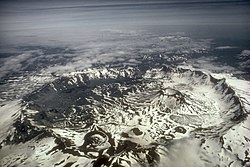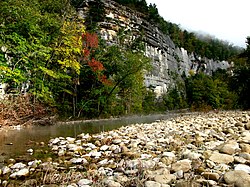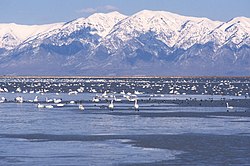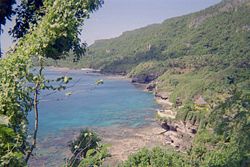Proposed U.S. national parks
| Proposed Name & Area | Photo | Location | Year | Notes | External information |
|---|---|---|---|---|---|
| Adirondack Mountain National Park |  | New York | 1967 | In 1967 Laurance Rockefeller proposed that a 1,720,000-acre (700,000 ha) National Park be established in the center of the Adirondack Park. [4] | A Report On A Proposed Adirondack Mountain National Park What Would an Adirondack National Park Look Like?, Adirondack Almanac |
| Ancient Forest National Park |  | California, Oregon | 2009 | Inclusion of wilderness and roadless areas of various national forests along coastal California-Oregon border, including Six Rivers National Forest, Klamath National Forest, Rogue River–Siskiyou National Forest, and Trinity National Forest, as a cohesive national park unit. [5] | Nativetreesociety.org Take A Closer Look At Proposed Ancient Forest National Park, National Parks Traveler |
| Aniakchak National Park & Preserve |  | Alaska | 1979 | An earlier version of the Alaska National Interest Lands Conservation Act (S.222), introduced by Sen. John Durkin included making a Aniakchak National Park & Preserve. It was eventually made Aniakchak National Monument and Preserve. [6] | S.222 - Alaska National Interest Lands Conservation Act of 1979 |
| Apostle Islands National Park |  | Wisconsin | 1930, 2024 | On May 9th, 1930, HR. 8763 was introduced, which would designate an Apostle Islands National Park. [7] In 2024, legislation was introduced by U.S. Representative Tom Tiffany to rename the national lakeshore as a national park, with Sand Island as a national preserve. [8] | Wisconsin's Apostle Islands could become America's newest national park, Milwaukee Journal Sentinel |
| Atchafalaya National Park |  | Louisiana | 2014 | Local Sierra Club chapter proposal for inclusion of Atchafalaya National Wildlife Refuge, the Sherburne Complex Wildlife Management Area, and the greater basin as a national park. [9] | Group: Create big Atchafalaya national park Sierra Club pushes for national park status |
| Bandelier National Park & Preserve |  | New Mexico | 2019 | Proposal by U.S. Senator Martin Heinrich to redesignate Bandelier National Monument as a National Park & Preserve. [10] | Heinrich Announces Plan to Establish Bandelier National Park and Preserve |
| Bering Land Bridge National Park |  | Alaska | 1979 | An earlier version of the Alaska National Interest Lands Conservation Act (S.222), introduced by Sen. John Durkin included making a Bering Land Bridge National Park. It was eventually made Bering Land Bridge National Preserve. [6] | S.222 - Alaska National Interest Lands Conservation Act of 1979 |
| Big Thicket National Park |  | Texas | 1973 | On January 11th, 1973, S.314 was introduced by Senator Lloyd Bentsen, which would designate a Big Thicket National Park. [11] The East Big Thicket Association and a later successor organization lobbied for the creation of the national park for decades starting in 1936. The alternative National Preserve was ultimately passed. [12] | HEARINGS BEFORE THE SUBCOMMITTEE ON PARKS AND RECREATION OF THE COMMITTEE ON INTERIOR AND INSULAR AFFAIRS. UNITED STATES SENATE |
| Buffalo River National Park & Preserve |  | Arkansas | 2023 | Runway group proposal for redesignation of the Buffalo National River as a National Park & Preserve. [13] | A National Park would preserve the Buffalo River way of life. - Coalition for the Future of the Buffalo River National Park & Preserve Arkansas group floats idea of Buffalo National River into national park preserve - Arkansas Advocate |
| Cape Krusenstern National Park |  | Alaska | 1979 | An earlier version of the Alaska National Interest Lands Conservation Act (S.222), introduced by Sen. John Durkin included making a Cape Krusenstern National Park. It stayed as Cape Krusenstern National Monument. [6] | S.222 - Alaska National Interest Lands Conservation Act of 1979 |
| Chiricahua National Park |  | Arizona | 2016 | Nearby town of Wilcox, AZ has been pushing for redesignation of Chiricahua National Monument as a national park. First introduced in the U.S. House of Representatives in 2016 and in the U.S. Senate in 2019. [14] [15] Re-introduced in both in 2021-2022, [16] [17] and then 2023. [18] [19] | Will this hidden gem become a tourist attraction? How park status could affect Chiricahuas |
| Colorado Canyons National Park |  | Colorado | 1906, 2012 | John Otto lobbied for the creation of a national park, convincing locals in Grand Junction of the cause. Bills were introduced in Congress, but William Howard Taft ultimately declared Colorado National Monument. [20] Several locals in Grand Junction, Colorado began promoting the idea of elevating the status of the monument to a national park in the early 2010s. [21] | Disputing Whether a Treasure Needs a Name Upgrade, The New York Times, 2012 Talk of monument getting park designation, TheDailySentinel, 2017 |
| Craters of the Moon National Park and Preserve |  | Idaho | 2015 | Butte County commissioner Rose Bernal and a group of other locals campaigned for National Park designation of Craters of the Moon National Monument and Preserve. The Idaho State Senate passed a referendum in support of the idea in 2015. [22] | Should this national monument become a national park? - HighCountryNews |
| Delaware River National Park & Lenape Preserve |  | New Jersey, Pennsylvania | 2021 | Retired Delaware Water Gap National Recreation Area superintendent John Donahue put forward a proposal for redesignating the park. Supported by local Sierra Club chapters. [23] [24] | Delaware River National Park & Lenape Preserve Alliance Alliance Proposal Delaware Water Gap could become the first national park in Pennsylvania, New Jersey - USAToday, 2021 |
| Dinosaur National Park |  | Colorado, Utah | 1992, 2015 | In the late 1980s and early 1990s, Robert Starr Waite, who successfully campaigned for the creation of Great Basin National Park, put together a similar proposal for designating Dinosaur National Monument a National Park. [25] In 2015, Congressman Jason Chaffetz and Rob Bishop put forward a plan to designate the monument a National Park. [26] | PARK STATUS AGAIN SOUGHT FOR DINOSAUR MONUMENT - Deseret News, 1992 |
| Driftless / Driftless Rivers / Upper Mississippi Valley National Parks |  | Iowa, Illinois, Minnesota, Wisconsin | 1909, 1930, 2006, 2023 | The Driftless area has been the focus of several proposals for a national park. In 1909, State Representative George Schulte proposed a national park at the confluence of the Wisconsin River and Mississippi River near McGregor, Iowa to the Iowa general assembly. [27] Later versions of this proposal stretched from St. Paul, Minnesota to Dubuque, Iowa through what is now the Upper Mississippi River National Wildlife and Fish Refuge. In 1915, US Senator William Kenyon introduced a bill (S. 4585) to establish a Mississippi Valley National Park. [28] In 1931, after studying the potential park, Roger W. Toll recommended preserving local Native American mounds as a small monument in what would become Effigy Mounds National Monument. [29] In 2023, a Rochester meteorologist proposed converting the Whitewater Wildlife Management Area, State Park, and nearby public lands into a Driftless National Park & Preserve, potentially stretching down the Mississippi river to Perrot State Park. [31] | The Movement to Create a National Park in Iowa driftlessrivers.org La Crosse Tribune Driftless National Park & Preserve Initiative With a proposal to turn the Driftless into a national park shelved, what happens next? - The Gazette |
| Escalante Canyons National Park and Preserve |  | Utah | 1940, 2017 | The National Park Service considered designating a national park unit in the 1930s and early 1940s. [32] In 2017, US Representative Chris Stewart introduced legislation designating a national park out of the Escalante Canyons unit of Grand Staircase–Escalante National Monument, legislation which he re-introduced in 2020. [33] | Rep. Stewart once again proposes new national park in Utah, FOX13Now, 2020 |
| Fall Creek Falls National Park |  | Tennessee | 1937 | In 1937, regional director of the NPS Conrad Wirth visited the Fall Creek Falls National Recreation Demonstration Project and thought the area should be kept by the NPS as a National Park. He sent seven park planners to the area several months later, who were unimpressed by the waterfalls due to a drought. The park was turned over to the state of Tennessee as Fall Creek Falls State Park in 1944. [34] | Almost a National Park: The Early Days of Fall Creek Falls State Park - The Tennessee Conservationist |
| Florida Springs National Park |  | Florida | 2025 | In 2022, the Florida Springs Institute proposed a "Great Springs & Rivers National Park" to permanently protect multiple first-magnitude springs, their springsheds, and stretches of rivers. [35] In August 2025, Representative Randy Fine introduced legislation to commission a special resource study, directing the Department of Interior to study a potential Florida Springs National Park in the area of Ocala National Forest, Paynes Prairie Preserve State Park, De Leon Springs State Park, and other already protected lands in north-central Florida. [36] | Mark Woods: An idea for an addition to America's Best Idea — Florida Springs National Park, Jacksonville Florida Times-Union |
| Great Rivers National Park |  | Illinois, Missouri | 2023 | Local group AltonWorks introduces proposal for a national park spanning much of the confluence of the Mississippi River and Missouri River near Alton, Illinois, including various public lands such as much of the Mark Twain National Wildlife Refuge Complex and Pere Marquette State Park. [37] | Plan for proposed Great Rivers National Park debuts, TheTelegraph |
| Great Salt Lake National Park |  | Utah | 2023 | Paul Alan Cox proposed a national park to protect the Great Salt Lake, which is increasingly under threat from water scarcity. [38] | Opinion: Making the Great Salt Lake into a national park, DesertNews, 2023 |
| Guana River National Park |  | Florida | 1973 | On January 3rd, 1973, H.R.383 was introduced by Representative Bill Chappell, which would designate a Guana River National Park. [39] Part of the area is currently protected by the Guana Tolomato Matanzas National Estuarine Research Reserve. | H.R.383 - To provide for the establishment of the Guana River National Park in the State of Florida, and for other purpose. |
| Hells Canyon National Park |  | Idaho, Oregon | 1940, 1990 | Amid talks of the Forest Service joining the Department of the Interior in 1940, there was a growing push for a Hells Canyon National Park. [40] In 1990, a group of locals pushed for a Hells Canyon National Park & Preserve. [41] | Hells Canyon: Should it be a park? - High Country News, 1990 3 national parks in Oregon that never happened - OregonLive, 2016 |
| High Allegheny National Park and Preserve |  | West Virginia | 2011 | In October 2011, the NPS announced [42] a Reconnaissance Survey of a National Park composed of portions of Monongahela National Forest at the request of US Senator Joe Manchin. Manchin withdrew his request in 2012. [43] | Are You Ready for High Allegheny National Park? - Woodshed, 2011 |
| Hooker Hammock National Park |  | Florida | 1930 | In the face of plans to convert the area to farmland, Mayor C. S. Donaldson and locals proposed a national park out of what is now Highlands Hammock State Park. [44] | Correspondence of proposed Hooker Hammock National Park, npshistory.com |
| Katahdin/Maine Woods National Park |  | Maine | 1920, 1937, 1991, 2011 | In 1920, eventual Governor Percival P. Baxter participated in an expedition to the top of Mount Katahdin to investigate its potential as a national park. Later in life, he would personally buy tracks of land and established Baxter State Park. [45] U.S. Representative Owen Brewster introduced legislation for a Mt. Katahdin National Park in 1937. [46] In 1991, New England-based conservation group RESTORE:The North Woods proposed a 3,200,000-acre (1,300,000 ha) Maine Woods National Park surrounding Baxter State Park. [47] Roxanne Quimby, after speaking with RESTORE, began purachasing land around Baxter State Park, and revealed her plan for a Maine North Woods National Park in 2011. On August 24, 2016, President Barack Obama proclaimed 87,563 acres (35,435 ha) of her donated land as the Katahdin Woods and Waters National Monument. [48] | Maine Woods National Park Photo-Documentation Project RESTORE:The North Woods A Maine Woods National Park? |
| Kaua'i National Park |  | Hawaii | 1965 | The National Park Service proposed a park connecting areas of public land, including Nā Pali Coast State Park, Waimea Canyon State Park, Haʻena State Park, and Kōkeʻe State Park. [49] | Kauai National Park - A Proposal, NPS 1965 |
| Lake Tahoe National Park |  | California, Nevada | 1897, 1917 | John Muir, saddened by logging in the Lake Tahoe area, began campaigning for a national park in 1897. The proposal collapsed in Congress over concerns of federal control. [50] | Why Lake Tahoe Never Became a National Park, Moonshineink, 2016 |
| Mattole-Humboldt National Park |  | California | 1936 | The National Park Service investigated the potential of a national park or national seashore recreation area on California's Lost Coast. [51] Part of the area is now protected by the Bureau of Land Management in the King Range National Conservation Area. | Study of a National Seashore Recreation Area |
| Mobile-Tensaw Delta National Park |  | Alabama | 2013 | Biologist E. O. Wilson proposed a large national park encompassing most of the Mobile-Tensaw River Delta to protect high levels of biodiversity in the region. In 2017, the National Park Service highlighted interest in the region in a report. [52] | Protecting Biodiversity Through National Park System Expansion, National Parks Traveler Push for a new national park in Alabama is an upstream battle, PBSNewsHour, 2016 |
| Mojave National Park |  | California | 1979 | H.R.4461 first proposed a Mojave National Park on June 14th, 1979. An earlier version of the California Desert Protection Act of 1994 (S.222), introduced by Sen. Alan Cranston continued this. It was eventually made Mojave National Preserve. [53] | S.2061 - California Desert Protection Act of 1986 |
| Moraine National Park |  | Wisconsin | 1958 | Ray Zillmer proposed a narrow 500-mile (800 km) national park along the terminus moraine through Wisconsin. The National Park Service took interest in the idea, but instead proposed more concise park, with great interest for potential park units in Kettle Moraine State Forest and the Baraboo Range. U.S. Representative Henry S. Reuss introduced legislation for the park in 1958. After Zillmer's death in 1960, Reuss continued the idea into what is today the Ice Age National Scenic Trail and the Ice Age National Scientific Reserve. [54] | Correspondence of Moraine Nation Park, npshistory.com |
| Mount Hood National Park |  | Oregon | 1940, 2003 | Amid talks of the Forest Service joining the Department of the Interior in 1940, there was a growing push for a Mount Hood National Park. [40] Tom Kloster has run a campaign for creating a Mount Hood National Park & Preserve that would link together the Mount Hood National Forest and the Oregon side of Columbia River Gorge. [55] | 3 national parks in Oregon that never happened - OregonLive, 2016 Mount Hood National Park Campaign |
| Mount Shasta National Park |  | California | 1888, 1912 | John Muir first proposed a Mount Shasta National Park in 1888, saying ""The Shasta region may be reserved as a national park, with special reference to the preservation of its fine forests and game. This should by all means be done". The idea again picked up steam, with John E. Raker introducing legislation in 1912. The bill made it out of committee with approval, but Congress ended before a vote. [56] | The Mount Shasta National Park Movement: Its Origin and Development |
| Mount St. Helens National Park |  | Washington | 2007 | Forest Service cuts in 2007 led to the closing of two visitor centers at Mount St. Helens National Volcanic Monument, sparking a campaign to transfer the monument into the NPS as a National Park. [57] | An area unlike any in the world: Make Mount St. Helens a national park - TheSeattleTimes |
| Niobrara-Buffalo Prairie National Park |  | Nebraska | 1990 | In the 1991 legislation designating the Niobrara National Scenic River, a clause was included directing the NPS to study the potential of a 138,000-acre (56,000 ha) National Park along the corridor and on the edge of the Nebraska Sandhills. [58] The NPS reported favorably in their final survey, but took no further official stance. [59] | Can We Save Vanishing Grasslands?, National Parks Traveler Niobrara National Park Study-Nebraska, National Park Service |
| Noatak National Park |  | Alaska | 1979 | An earlier version of the Alaska National Interest Lands Conservation Act (S.222), introduced by Sen. John Durkin included making a Noatak National Park. It was eventually made Noatak National Preserve. [6] | S.222 - Alaska National Interest Lands Conservation Act of 1979 |
| Ocmulgee Mounds National Park & Preserve |  | Georgia | 2017 | Campaign for designating the Ocmulgee Mounds National Historical Park, and surrounding lands including the Bond Swamp National Wildlife Refuge, as a national park & preserve along the Ocmulgee River south of Macon, Georgia. [60] U.S. Senators Jon Ossoff and Raphael Warnock introduced legislation for the creation of the park in 2024. [61] | Ocmulgee National Park & Preserve Initiative 4 lawmakers introduce legislation to make Ocmulgee Mounds state's first National Park and Preserve An Economic Analysis of the Proposed Ocmulgee National Park and Preserve - NPCA |
| Okefenokee National Park |  | Georgia | 1929 | HR. 17277 was introduced in the 70th Congress, which commanded the secretary of the Interior to study the potential of establishing an Okefenokee National Park in the Okefenokee Swamp. [62] | History of Legislation Relating to The National Park System Through the 82d Congress |
| Oregon Coast National Park |  | Oregon | 1938 | Effort by locals for designation of land between Gold Beach, Oregon and Brookings, Oregon to be designated as a National Park. U.S. Senator Charles McNary introduced a bill in congress. [32] [63] | In search of the lost Oregon Coast National Park, TheOregonian, 2017 |
| Ouachita National Park |  | Arkansas | 1929 | Effort by U.S. Senator Joseph T. Robinson and U.S. Representative Otis Wingo for a National Park near what is now the Caney Creek Wilderness in Ouachita National Forest. Ended with a pocket veto by President Calvin Coolidge. [64] | TOM DILLARD: Arkansas once envisioned as home for Ouachita National Park - ArkansasDemocratGazette, 2020 |
| Palo Duro Canyon National Park |  | Texas | 1906 | The Canyon City Commercial Club passed a resolution in favor of a National Park for the Palo Duro Canyon in 1906. U.S. Representative John H. Stephens introduced multiple acts establishing the park between 1908 and 1915. [65] | Texas State Historical Association, 1976 |
| Red River Gorge National Park |  | Kentucky | 1974 | On October 9th, 1974, Senate Resolution 4107 was introduced by Senator Marlow Cook, which would designate a Red River Gorge National Park. [66] The park was proposed to stop the Red River Lake Project authorized by the Flood Control Act of 1962, and would preserve the designated RRG Geologic Area under the Department of Interior. Senator Cook spoke of broad community support in his address to the senate. [67] | A bill to establish the Red River Gorge National Park, Ky., to deauthorize the Red River Lake project. |
| Ricketts Glen National Park |  | Pennsylvania | 1930s | The area of what is now Ricketts Glen State Park was approved to be a national park, with the Civilian Conservation Corps establishing a camp in the area. World War II put an end to these plans. [68] | History of Ricketts Glen State Park |
| Rota National Park |  | Northern Mariana Islands | 2009 | Rota Senator Diego Songao proposed a national park to U.S. Delegate Gregorio Sablan, who then lobbied for a special resource study of the idea. In 2023, the NPS found that the area meets many qualities of a national park, but that NPS management is not directly needed. [69] | SaipanTribune, 2013 |
| Sawtooth National Park |  | Idaho | 1960 | U.S. Senator Frank Church proposed a national park for the Sawtooth Range. After introducing legislation for either a park or National Recreation Area, and after pushback for locals, the Sawtooth National Recreation Area was established in 1972. [70] | Why there's no national park in the Sawtooths — and why that matters Boise State Public Radio News, 2022 |
| Shawnee National Park & Climate Preserve |  | Illinois | 2021 | Local group pushing for transferring the Shawnee National Forest to the National Park Service, citing logging and the need for preserving eastern forest environments. [71] The city of Carbondale, Illinois passed a resolution in 2022 in support of the proposal. [72] | Shawnee National Park? -IllinoisTimes, 2023 Shawnee Forest Defense |
| Sierra Madre National Park |  | California | 1916 | U.S. Representative Charles Hiram Randall introduced legislation to create a national park out of the San Gabriel Mountains. Despite broad local support, Stephen Mather dismissed the idea. [73] | The Lost Plan to Create a National Park in L.A.'s Backyard, 2021 |
| Silver Falls National Park |  | Oregon | 1902, 2008 | In 1902, June D Drake began to campaign for park status of Silver Falls State Park. In 1926, however, an inspector for the National Park Service rejected the area for park status because of a proliferation of unattractive stumps after years of logging. [74] In 2008, Fred Girod of the Oregon House of Representatives sought federal designation of the area as a national park via a house joint memorial to the United States Congress, but the bill died in committee. [75] | Silver Falls State Park and the Early Environmental Movement, Oregon Historical Society, 2011 |
| Sonoran Desert National Park |  | Arizona | 1966, 1998 | Stewart Udall, then as Secretary of the Department of the Interior and as a former Arizona U.S. Representative, proposed a sprawling Sonoran Desert National Park in 1966. The proposal included the Organ Pipe Cactus National Monument and Cabeza Prieta National Wildlife Refuge. [76] [77] In 1998, a group of citizens resurrected the proposal. [78] | Sonoran Desert National Park, Arizona: A Proposal - NPS Sonoran Desert National Park, National Border, National Park: A History of Organ Pipe Cactus National Monument The Attempt to Create the Sonora Desert National Park, DesertUSA, 2000 |
| Tensas Swamp National Park |  | Louisiana | 1938 | The Audubon Society persuaded U.S. Senator Allen J. Ellender to establish a National Park in Tensas River National Wildlife Refuge, the last remaining possible refuge of the now thought-to-be extinct Ivory-billed Woodpecker [79] [32] | The Resurrection of the Lord God Bird, Wisconsin Academy of Science, Arts, and Letters, 2015 |
| Wichita Mountains National Park |  | Oklahoma | 1930 | HR. 13191 was introduced in the 71st Congress, which would designate a Wichita Mountains National Park. [80] | History of Legislation Relating to The National Park System Through the 82d Congress |
| Yukon–Charley National Park |  | Alaska | 1979 | An earlier version of the Alaska National Interest Lands Conservation Act (S.222), introduced by Sen. John Durkin included making a Yukon-Charley National Park. It was eventually made Yukon–Charley Rivers National Preserve. [6] | S.222 - Alaska National Interest Lands Conservation Act of 1979 |